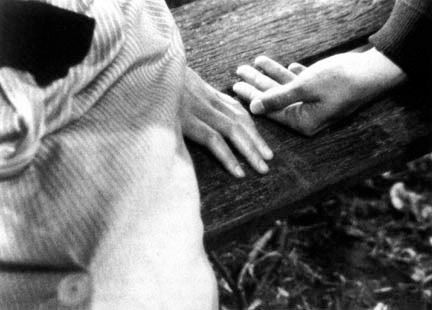or By Chance, Balthazar
And Diary of a Country Priest.
It's been a few months since I've seen either film, but I made fairly extensive notes immediately after watching them and found those notes recently, so I'm going to do an entry on Au Hasard Balthazar and Diary of a Country Priest. The focus will be on Au Hasard Balthazar, with Diary of a Country Priest acting as a secondary reference in regard to Bresson's technique and commonalities between his films.
I recommend watching Au Hasard Balthazar before reading any further; it's helpful to have seen Diary of a Country Priest, but not necessary, and I won't reveal any of its plot details.
Much has been said about Bresson's camera-work and its tendency to focus on details, especially hands and feet, rather than faces and environments. Yet I have read very little that explores why he does this. His intentions are probably varied, but I took particular note of the use of hands in these two films: the purpose of the hands in each film, and how the usage of hands in the two films differ.
Hands, in a broader symbolic sense, can represent dozens of things. Possession, craft, delicacy, power, any number of ideas. In Au Hasard Balthazar they appear to express possession, control, connection, sexuality; ultimately hands represent, through all these things, a tool by which to guide one's soul. They give one some determination over one's fate. All the people have hands that we see constantly, manipulating everything around them. Balthazar only has cloven hooves, incapable of handling objects, incapable of carressing someone, incapable of doing anything but moving where others tell him to move. Balthazar lacks control over his own soul, or his own fate, and is subject to the domineering hands of others.
Diary of a Country Priest has a different approach, and Bresson's focus on hands and details is less meticulous here. In this film, the camera only focuses on hands when spiritual exchanges occur, most notably the passing of the letter in the confessional and the blessing of the countess. It's worth noting that one must use one's hands to bless a person (or one's self) in typical Catholic fashion. It's admirable that Bresson should have such a distinct style, focusing on one detail, yet have the ability to evoke different responses in different contexts.
Back to Au Hasard Balthazar. Balthazar is a donkey (with, I might add, a Biblical name), often called a beast of burden; the nickname is appropriate in many ways. It immediately made me think of Christian, from John Bunyan's Pilgrim's Progress, when he begins his journey carrying a great burden on his back; the donkey, being a beast of burden, at once evokes the burden of Sisyphean labor and the burden of human sin (Balthazar silently bears the abuse he's given)*
